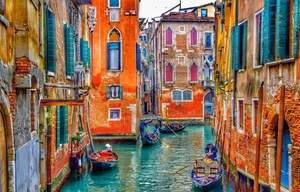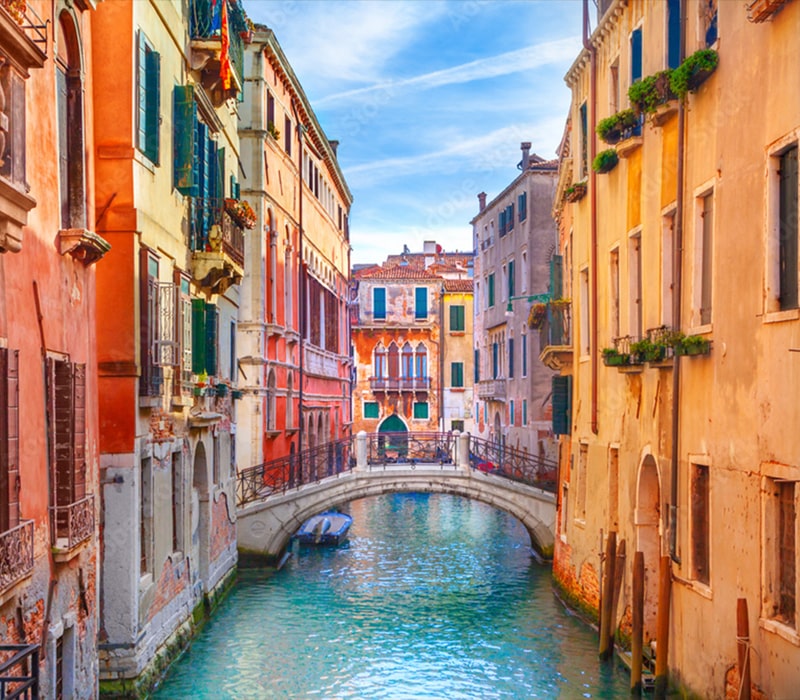Imagine stepping into a city where Gothic spires pierce the sky, Renaissance masterpieces line centuries-old walls, and the world’s most elegant shopping arcades glitter beneath iron-and-glass domes. Welcome to Milan, a city that effortlessly blends timeless artistry with modern sophistication, offering travellers an experience unlike any other among European cities.
While Rome captivates with ancient ruins and Florence enchants with Renaissance charm, Milan stands apart as Italy’s beating heart of innovation, fashion, and contemporary culture. This is where Leonardo da Vinci’s genius still resonates through cobblestone streets, where opera singers’ voices soar through gilded theatres, and where aperitivo hour transforms picturesque canals into vibrant social stages.
Post Contents
- The Magnificent Duomo di Milano: Where Your Journey Begins
- Galleria Vittorio Emanuele II: Italy’s Most Elegant Shopping Arcade
- Leonardo da Vinci’s The Last Supper: A Masterpiece Worth Planning For
- Teatro alla Scala: Opera in the World’s Most Prestigious Theatre
- Castello Sforzesco and Parco Sempione: Art, History, and Green Spaces
- Pinacoteca di Brera: Milan’s Premier Art Gallery
- Modern Milan: Contemporary Culture and Cutting-Edge Design
- Navigli District: Canals, Aperitivo, and Bohemian Charm
- Savouring Milan: Where to Eat Like a Local
- Planning Your Milan Itinerary: Sample Schedules
- Day Trips from Milan: Exploring Beyond the City
- F.A.Qs
- Ready to Begin Your Milan Adventure?
The Magnificent Duomo di Milano: Where Your Journey Begins
No visit to Milan is complete without standing before the breathtaking Duomo di Milano—the city’s crown jewel and one of the largest Gothic cathedrals in the world. Located in the heart of Piazza del Duomo, this architectural marvel took nearly six centuries to complete, and every intricate detail reveals the dedication of countless artisans who crafted its extraordinary beauty.
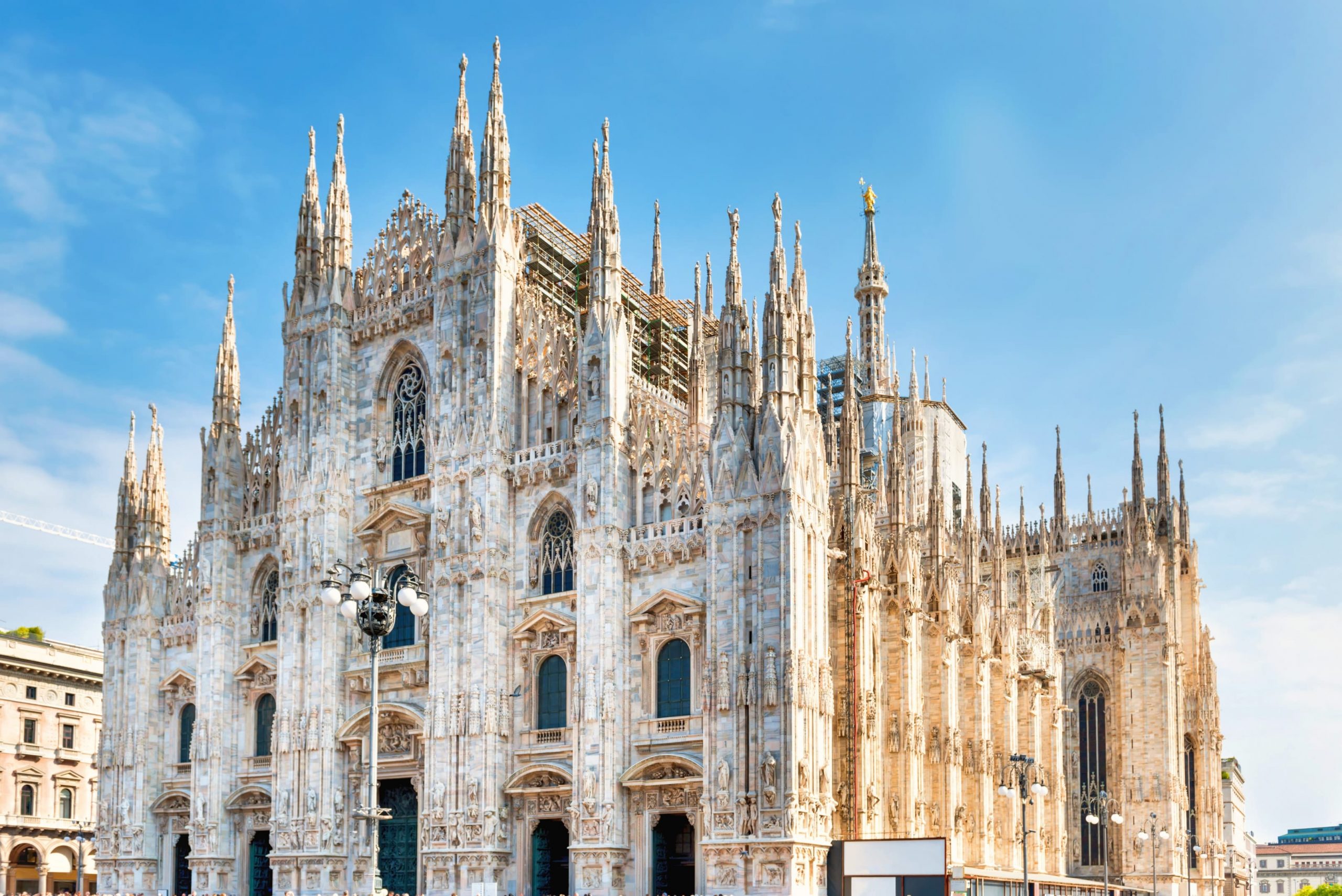
Duomo di Milano is a magnificent and world-famous cathedral located in the heart of Milan.
As you approach the cathedral’s ornate facade in the city centre, adorned with over 3,400 statues and 135 spires, you’ll understand why this magnificent structure captivates first-time visitors and seasoned travellers alike. The Duomo’s exterior, constructed from distinctive pink-hued Candoglia marble, changes character throughout the day, glowing softly in early morning light and turning golden during late afternoon hours.
The Rooftop Experience
The true highlight of any Milan itinerary is ascending to the Duomo’s famous rooftop terraces. Here, you’ll walk among Gothic spires and flying buttresses while enjoying panoramic views that stretch across central Milan to the distant Alps on clear days. This vantage point offers unparalleled insight into the city’s architectural landscape, where historic buildings nestle alongside striking examples of modern architecture.

It is one of the only churches in the world where visitors can walk all over the entire rooftop.
Practical Information:
- Rooftop access tickets cost approximately €15-20 (stairs) or €25-30 (elevator)
- Purchase tickets at the on-site ticket office or book online in advance to avoid queues
- Visit during early morning or late afternoon for the best lighting and fewer crowds
- This must-visit attraction is a short walk from most hotels in the city centre
Galleria Vittorio Emanuele II: Italy’s Most Elegant Shopping Arcade
Connected directly to the Duomo through the northern exit, the Galleria Vittorio Emanuele II stands as one of the world’s most iconic and beautiful places in Milan. This architectural masterpiece represents the seamless blend of function and beauty that defines the city centre.
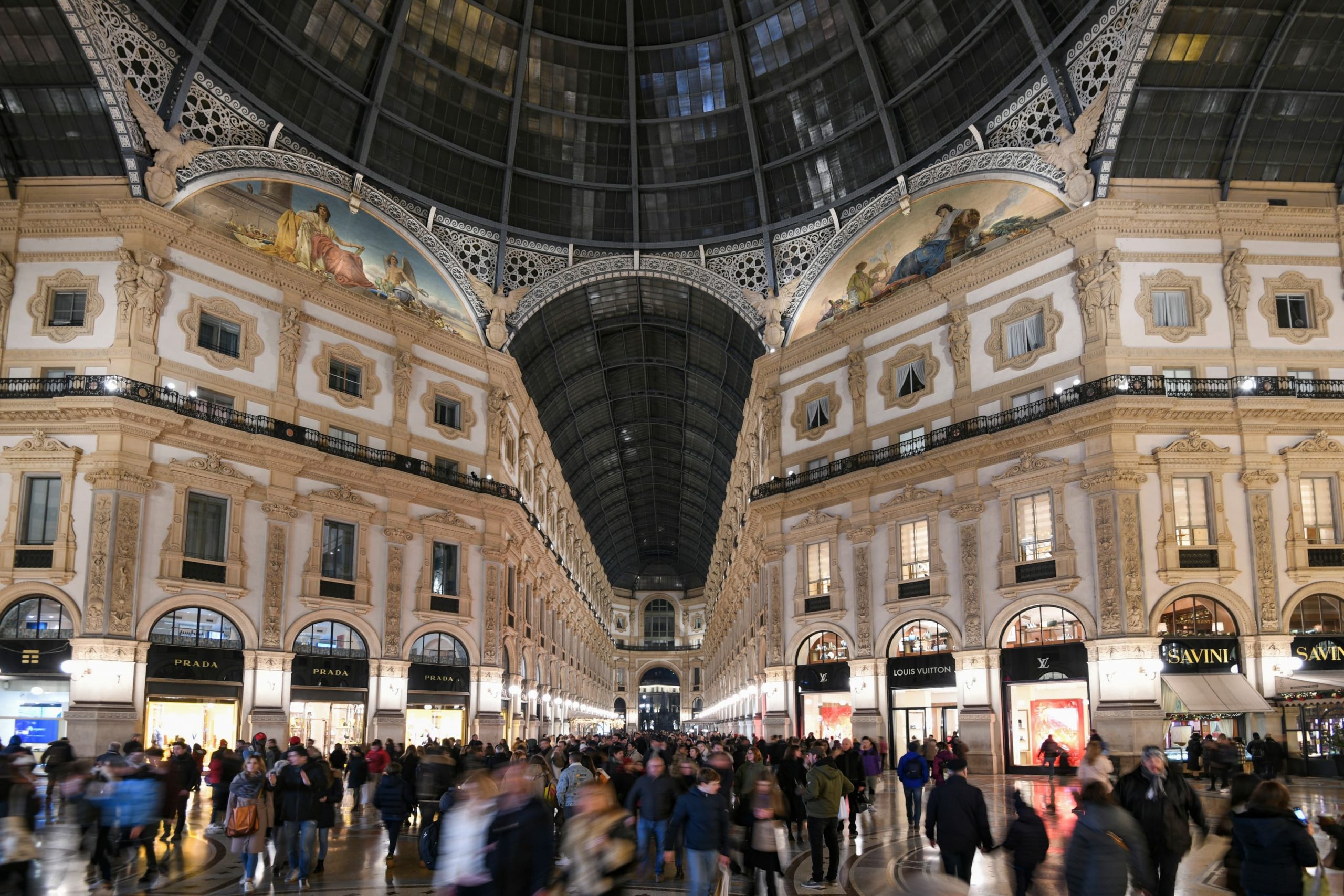
The Galleria houses many of the world’s most luxurious fashion brands.
The arcade’s elegant facades house flagship stores of the world’s most prestigious fashion houses, including Louis Vuitton, Prada, and Gucci. Even if luxury shopping isn’t on your Milan itinerary, simply strolling through this architectural wonder offers insight into the city’s refined aesthetic and its enduring role as a global fashion capital. The Galleria hosts several historic cafés where you can pause for lunch or an espresso surrounded by Belle Époque elegance, an idea that never disappoints.
Leonardo da Vinci’s The Last Supper: A Masterpiece Worth Planning For
Among all the amazing things to do in Milan, viewing Leonardo da Vinci’s “The Last Supper” (Il Cenacolo) ranks as perhaps the most profound experience. This iconic Renaissance masterpiece, painted between 1495 and 1498, adorns the refectory wall of Santa Maria delle Grazie—a UNESCO World Heritage church that draws art lovers from around the globe.
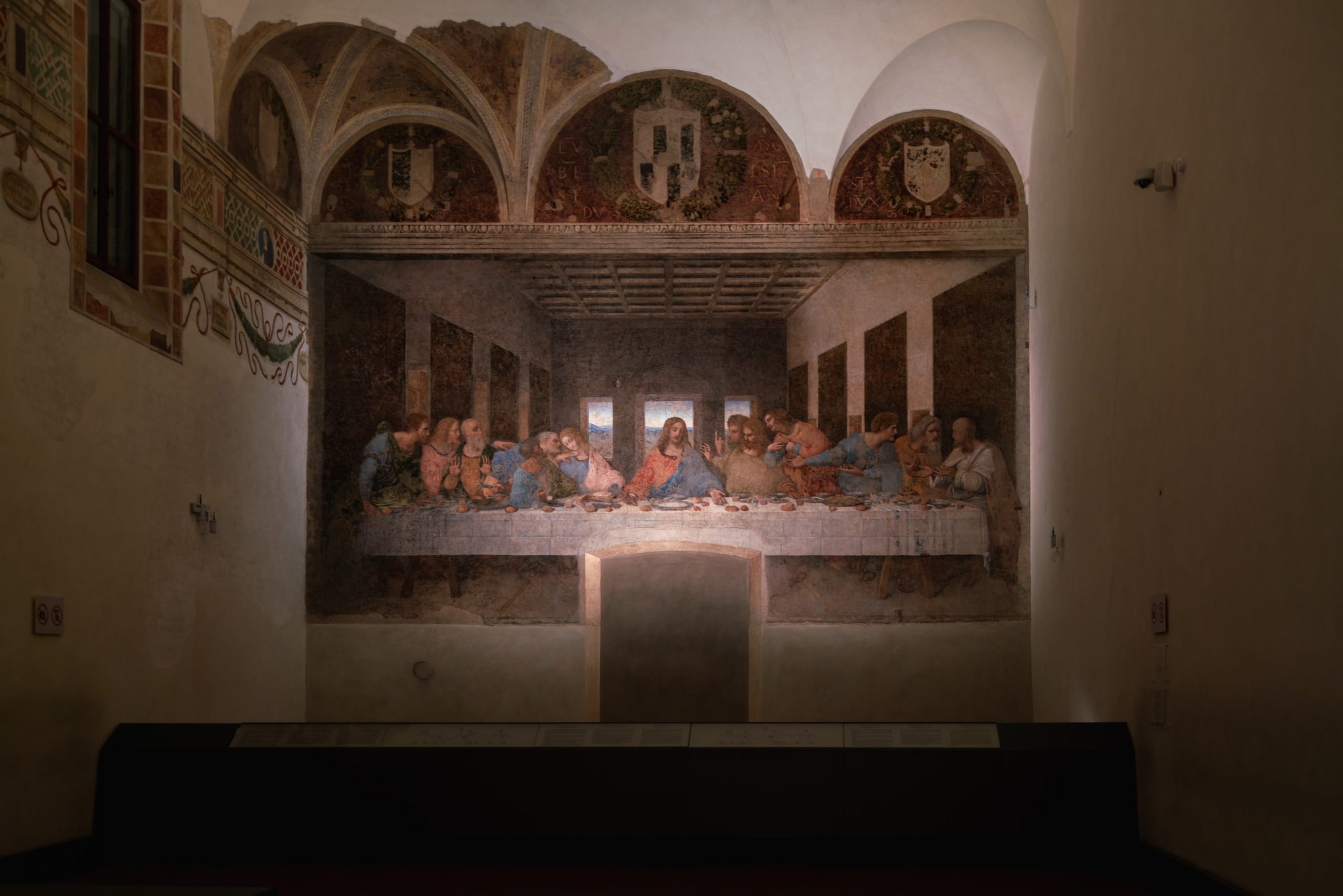
The painting depicts the moment immediately after Christ reveals that “One of you will betray me”.
Leonardo da Vinci’s revolutionary fresco captures the dramatic moment when Christ announces that one of his disciples will betray him. The composition’s emotional intensity, masterful use of perspective, and psychological depth make it one of the world’s most famous paintings. Despite suffering significant damage over the centuries, careful restoration has preserved this treasure for future generations to discover.
Practical Booking Advice:
- Book Last Supper tickets as early as possible through the official website (vivaticket.it)
- Supper tickets cost approximately €15-17 (plus €2 booking fee)
- If official tickets are sold out, consider booking a guided tour through a reputable provider (prices start around €50-80)
- Some last-minute cancellations become available, so check the ticket office regularly if you’re already in Milan
Teatro alla Scala: Opera in the World’s Most Prestigious Theatre
For centuries, La Scala Opera House (Teatro alla Scala) has represented the pinnacle of operatic performance in Italy and beyond. This legendary theatre, inaugurated in 1778, has witnessed the premieres of masterworks by Verdi, Puccini, Bellini, and Rossini, while hosting some of the greatest voices in opera history.
La Scala’s interior epitomises theatrical grandeur, with its horseshoe-shaped auditorium adorned in red velvet and gold leaf, creating an intimate yet majestic atmosphere. The acoustics are considered among the finest in the world. Attending a performance at Teatro alla Scala offers an unforgettable night that connects you with Milan’s cultural soul.

It was designed in the Neoclassical style by architect Giuseppe Piermarini.
Practical Information:
- Tickets range from approximately €30 for gallery seats to several hundred euros for prime orchestra and box seats
- Book well in advance through the official La Scala website
- Last-minute tickets sometimes become available at the box office on performance days
- This is one of the most amazing cultural experiences you can have in Milan
Castello Sforzesco and Parco Sempione: Art, History, and Green Spaces
The imposing Sforzesco Castle (Castello Sforzesco), with its distinctive brick walls and commanding towers, stands as a testament to Milan’s medieval power. Originally constructed in the 15th century by Francesco Sforza, Duke of Milan, this fortress now houses several art museums that contain some of Italy’s most significant artistic treasures.
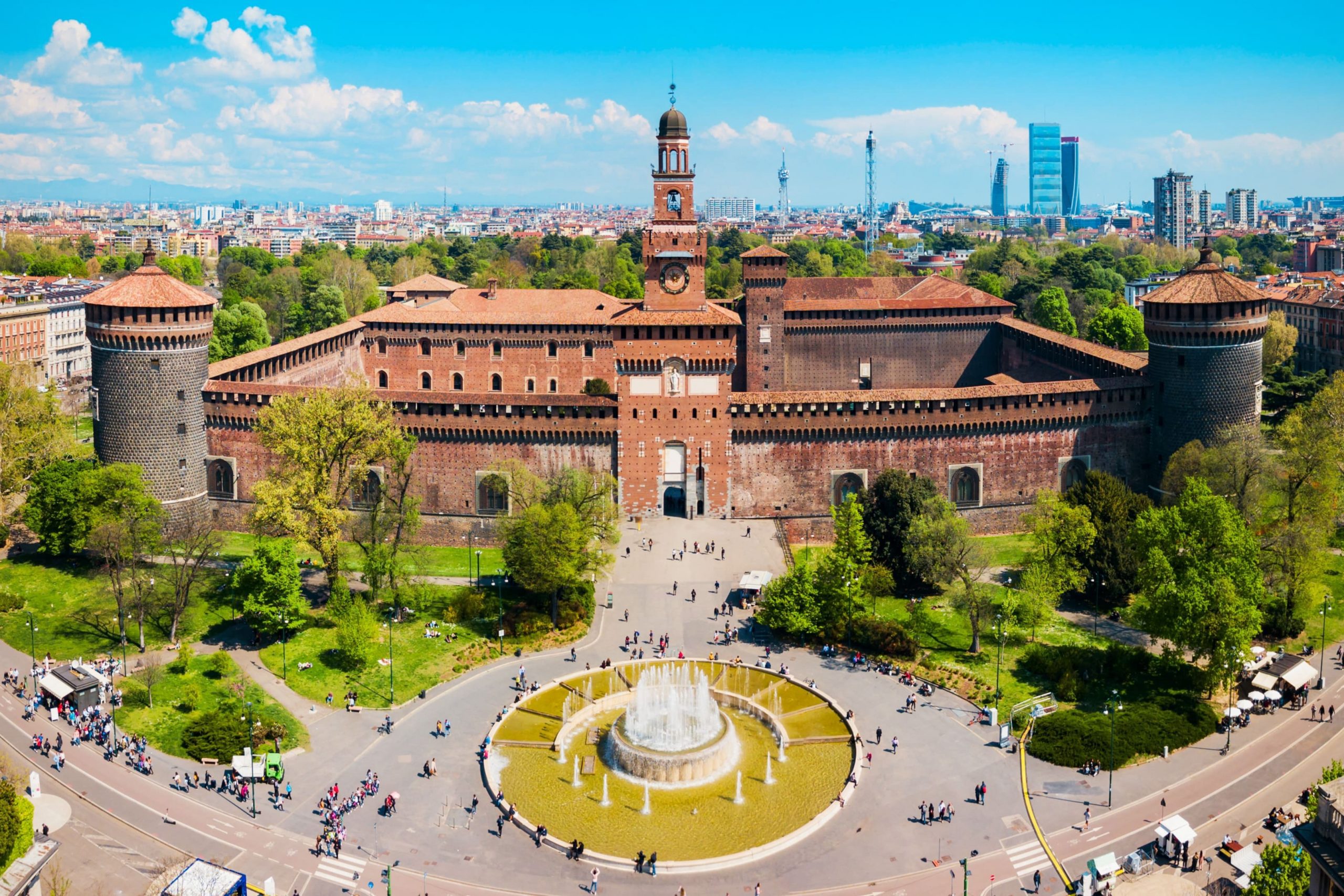
The Castello Sforzesco now houses several of Milan’s municipal museums and art collections.
Behind Castello Sforzesco stretches Parco Sempione, Milan’s largest central park. This green oasis offers a welcome respite from urban exploration, with tree-lined paths perfect for a morning walk and locals enjoying everything from jogging to picnicking. The park leads to the Arco della Pace (Arch of Peace). This neoclassical triumphal arch provides wonderful photo opportunities and marks one of the beautiful places where old and new Milan intersect.
Practical Information:
- Castle museums cost approximately €10 (combined ticket)
- Free entry during the last hour before closing on Tuesdays and Wednesdays
- Allow 2-3 hours to explore the museums and park properly
- Easily accessible by public transportation from the city centre
Pinacoteca di Brera: Milan’s Premier Art Gallery
Art connoisseurs will find their haven at the Pinacoteca di Brera, one of Italy’s most important art museums. Housed in a 17th-century palazzo in Milan’s artistic Brera neighbourhood, this gallery contains an extraordinary collection of Italian Renaissance and Baroque masterpieces that rival any museum in European cities.
Masterworks to Discover
The Brera’s collection focuses on Northern Italian art, with particular strengths in Venetian and Lombard painting. As you explore the gallery’s elegant rooms during your day in Milan, you’ll encounter famous paintings that have shaped art history and continue to inspire contemporary artists.
- Raphael’s “The Marriage of the Virgin”: This sublime early work demonstrates the young artist’s mastery of perspective and composition. The painting’s harmonious balance and serene beauty exemplify Renaissance ideals at their finest.
- Caravaggio’s “Supper at Emmaus”: Showcasing the master’s revolutionary use of dramatic light and shadow, this powerful work draws viewers into the moment of Christ’s revelation to his disciples. The emotional intensity and realistic detail demonstrate why Caravaggio transformed European painting.
- Mantegna’s “Dead Christ”: Perhaps the museum’s most startling image, this painting uses extreme foreshortening to create an almost photographic immediacy. The technique forces viewers to confront mortality with uncomfortable directness—a bold artistic choice that still resonates today.
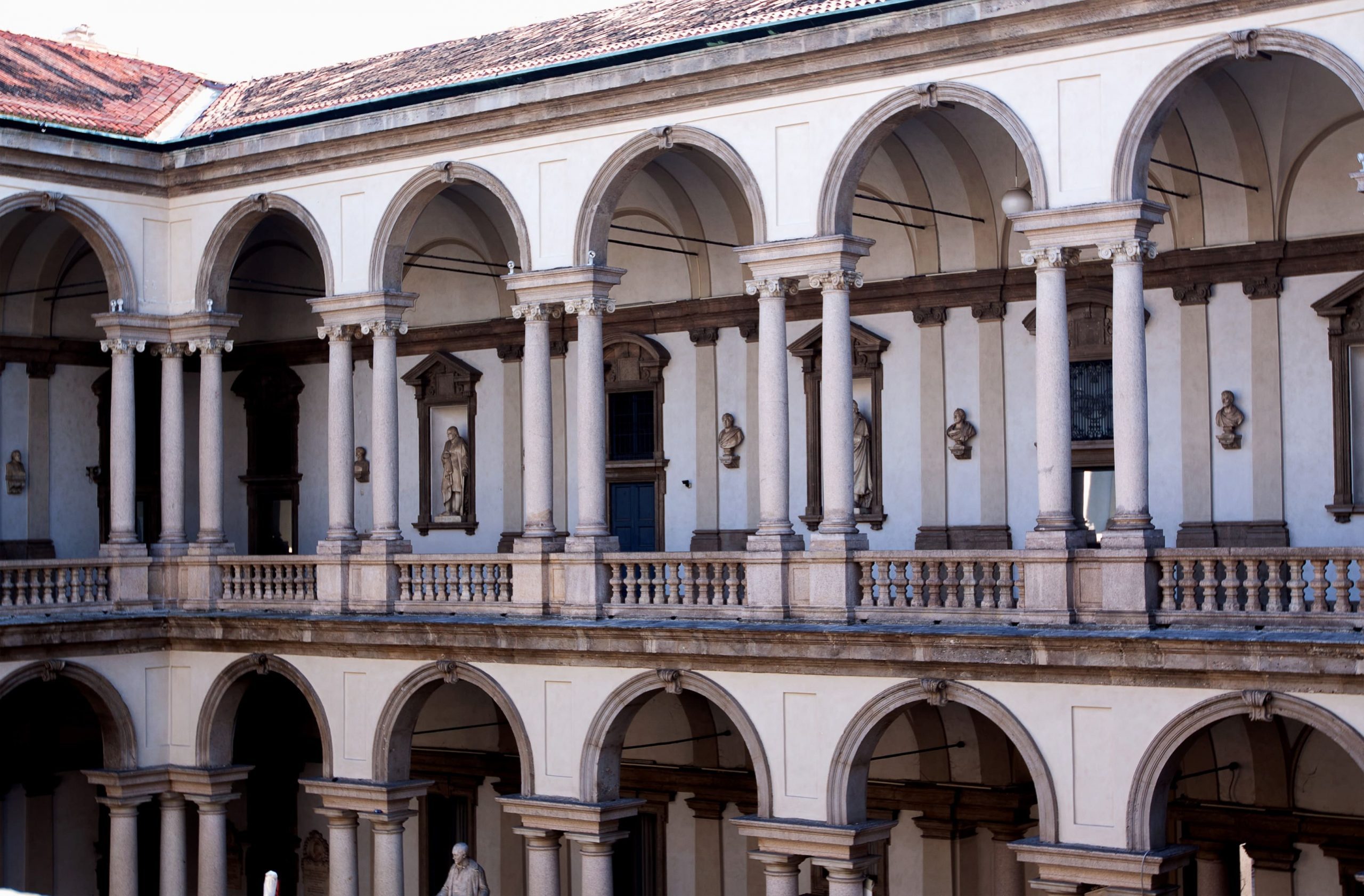
The Pinacoteca di Brera (Brera Art Gallery) is one of the most important art museums in Milan and Italy.
The collection also includes significant works by Piero della Francesca, Giovanni Bellini, Tintoretto, Veronese, and many other Renaissance and Baroque masters. Unlike larger art museums where famous paintings compete for attention, the Brera’s thoughtful curation and intimate scale allow you to engage deeply with individual masterpieces, discovering details and connections you might otherwise miss.
Exploring the Brera Neighbourhood
The museum sits in the heart of the charming Brera neighbourhood, an area that has attracted artists, intellectuals, and bohemians for generations. After exploring the Pinacoteca di Brera, take time to wander through these atmospheric streets where creativity seems to emanate from every corner—this is the local experience many travel bloggers rave about.
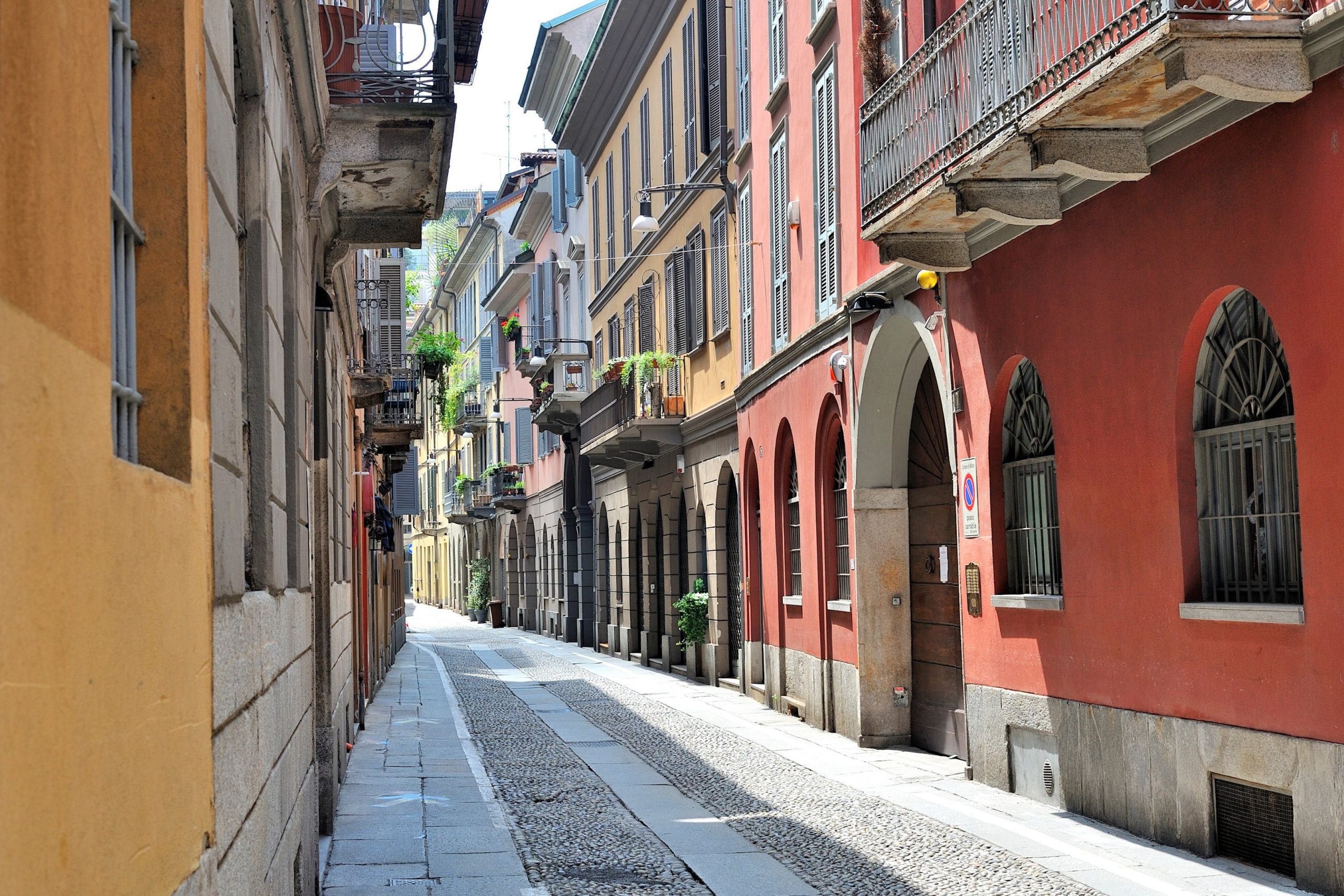
The cultural life of the neighborhood largely revolves around the historic Palazzo Brera.
The Brera district also hosts numerous restaurants ranging from traditional trattorias serving classic Milanese cuisine to innovative establishments pushing culinary boundaries. This neighbourhood truly comes alive during aperitivo hour and into the night, when locals fill the streets and piazzas, creating a vibrant social atmosphere that invites you to linger and experience Milan’s sophisticated yet welcoming culture.
Practical Information:
- Entrance fees are approximately €15-18
- Free entry on the first Sunday of each month (expect crowds)
- Audio guides available for enhanced understanding
- The museum is closed on Mondays
Modern Milan: Contemporary Culture and Cutting-Edge Design
While Milan’s Renaissance treasures rightfully command attention, the city’s commitment to contemporary culture is equally impressive. This forward-thinking approach manifests in world-class museums and architectural landmarks that demonstrate why Milan remains at Europe’s creative vanguard, constantly evolving while honouring its extraordinary history.
Museums of Modern Art
Museo del Novecento: Overlooking Piazza del Duomo from its prime position in the Palazzo dell’Arengario, this museum traces 20th-century Italian modern art through an impressive collection that includes Futurist works, metaphysical paintings, and contemporary installations. The building itself, with its distinctive spiral ramp, offers stunning cathedral views through floor-to-ceiling windows, creating a unique dialogue between historic and modern Milan. This cool museum is an idea worth adding to your Milan itinerary, especially if you have a long weekend to explore.
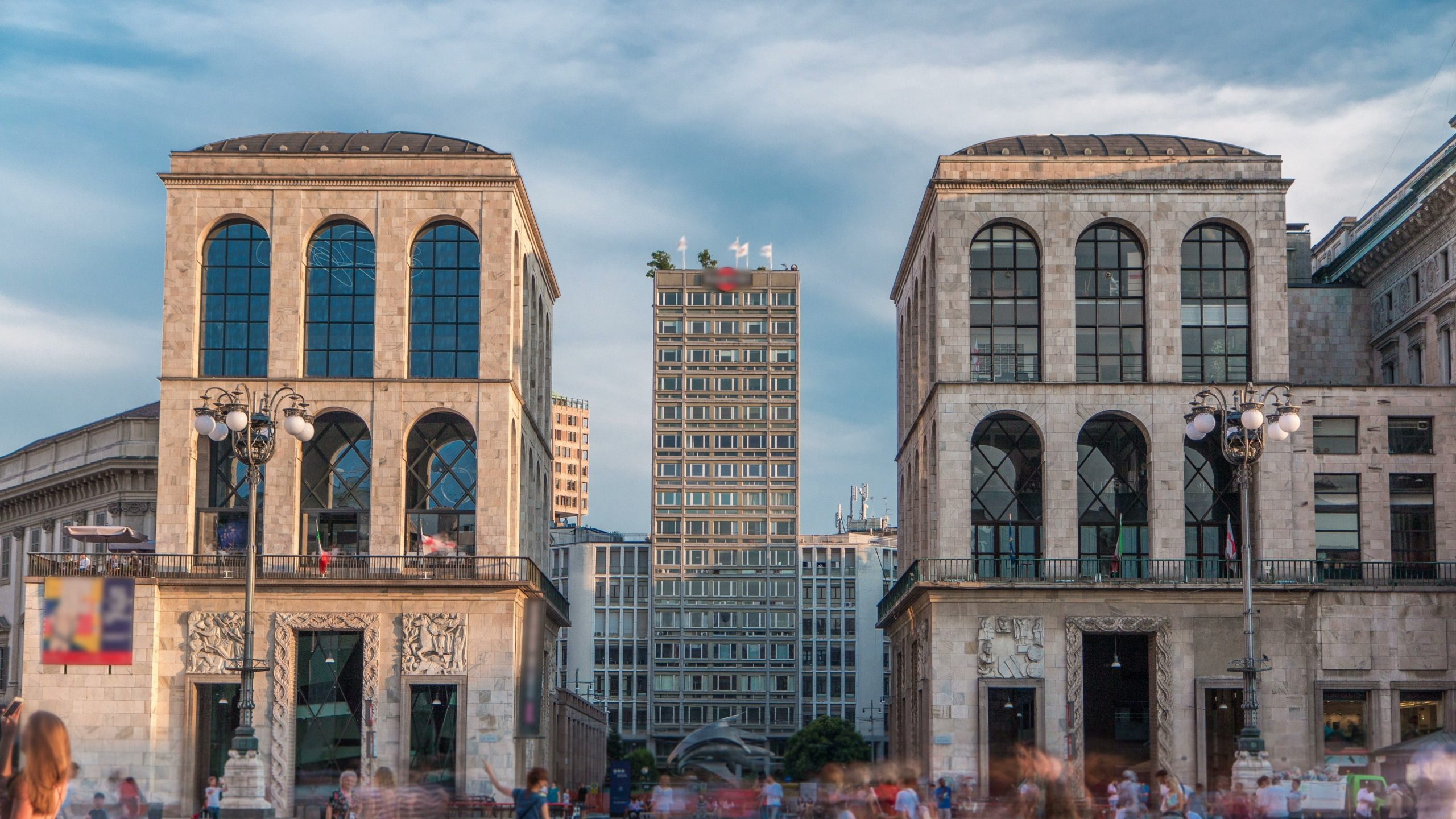
The museum displays a selection from Milan’s civic art collections.
Fondazione Prada: Designed by renowned architect Rem Koolhaas, this contemporary art complex in the southern part of the city combines preserved industrial buildings with striking new structures featuring modern architecture. The galleries showcase rotating exhibitions of contemporary art, while the café (designed by filmmaker Wes Anderson in his signature whimsical style) has become an attraction in its own right, offering a pastel-hued respite where art and daily life intersect beautifully.
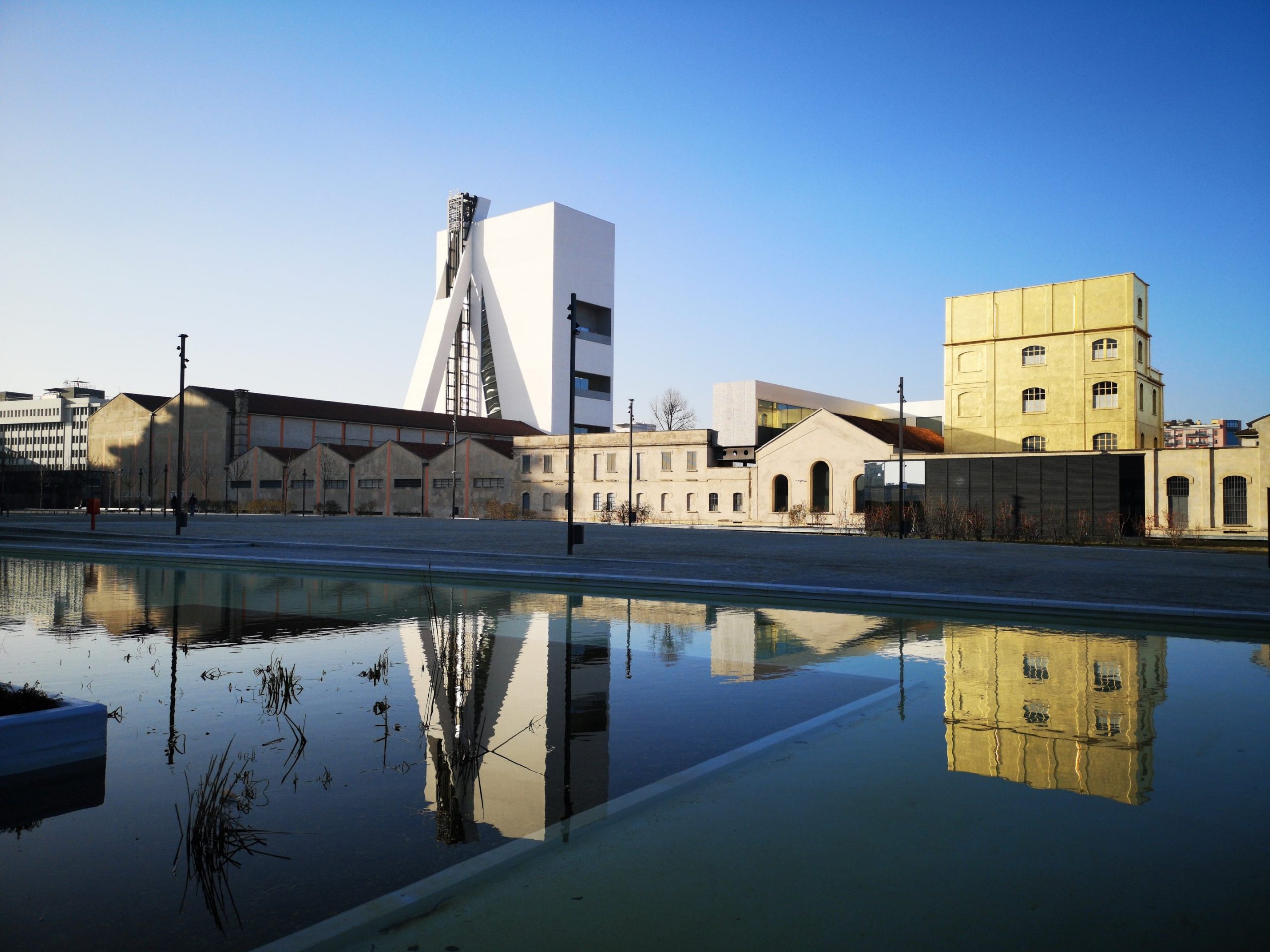
The main venue is located in Largo Isarco, in the south of Milan.
Architectural Innovation
Milan’s skyline increasingly features bold contemporary architecture that creates fascinating dialogue with historic buildings, proving that respecting the past doesn’t mean rejecting the future.
Bosco Verticale (Vertical Forest): These residential towers, covered in thousands of trees and plants representing approximately two hectares of forest, represent innovative approaches to urban sustainability. Designed by Stefano Boeri, the buildings demonstrate how cities can incorporate nature vertically, improving air quality and providing habitat for birds and insects. While you can’t tour the interiors, viewing these remarkable buildings from the nearby Porta Nuova district offers insight into Milan’s architectural ambition and environmental consciousness—one of the hidden gems that showcase the city’s forward-thinking spirit.
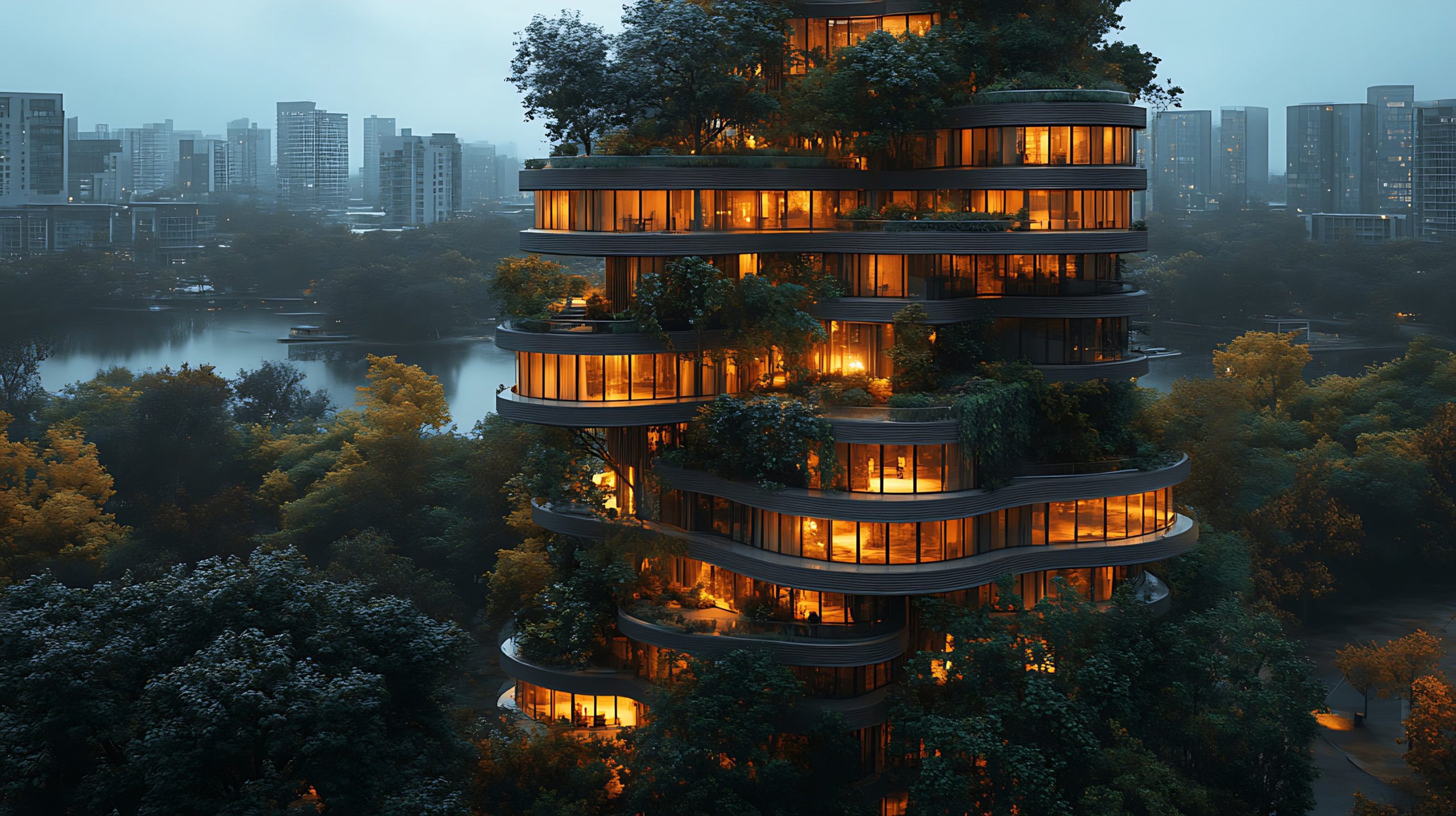
The vegetation is composed of over 90 different plant species.
CityLife District: This modern development features towers designed by Zaha Hadid, Arata Isozaki, and Daniel Libeskind, along with a large public park. The district represents Milan’s vision for 21st-century urban living, where residential, commercial, and green spaces coexist harmoniously. The three towers, each with its distinctive architectural personality, have transformed Milan’s skyline and demonstrated the city’s commitment to world-class design.

CityLife is recognized as a global model for sustainable urban transformation.
When locals want to experience Milan at its most relaxed and authentic, they head to the Navigli district. This neighbourhood, built around the picturesque canals designed partly by Leonardo da Vinci, offers an entirely different atmosphere from central Milan’s grand monuments—here, life unfolds at a more leisurely pace, particularly during evening hours when the waterfront transforms into one of the city’s most vibrant social scenes.
The Naviglio Grande and Naviglio Pavese, collectively known as the Navigli canals, once formed part of an extensive waterway system that connected Milan to the surrounding countryside and major rivers, facilitating trade and transportation for centuries. The engineering genius behind parts of this system came from Leonardo da Vinci himself, who designed innovative lock systems during his time in Milan.
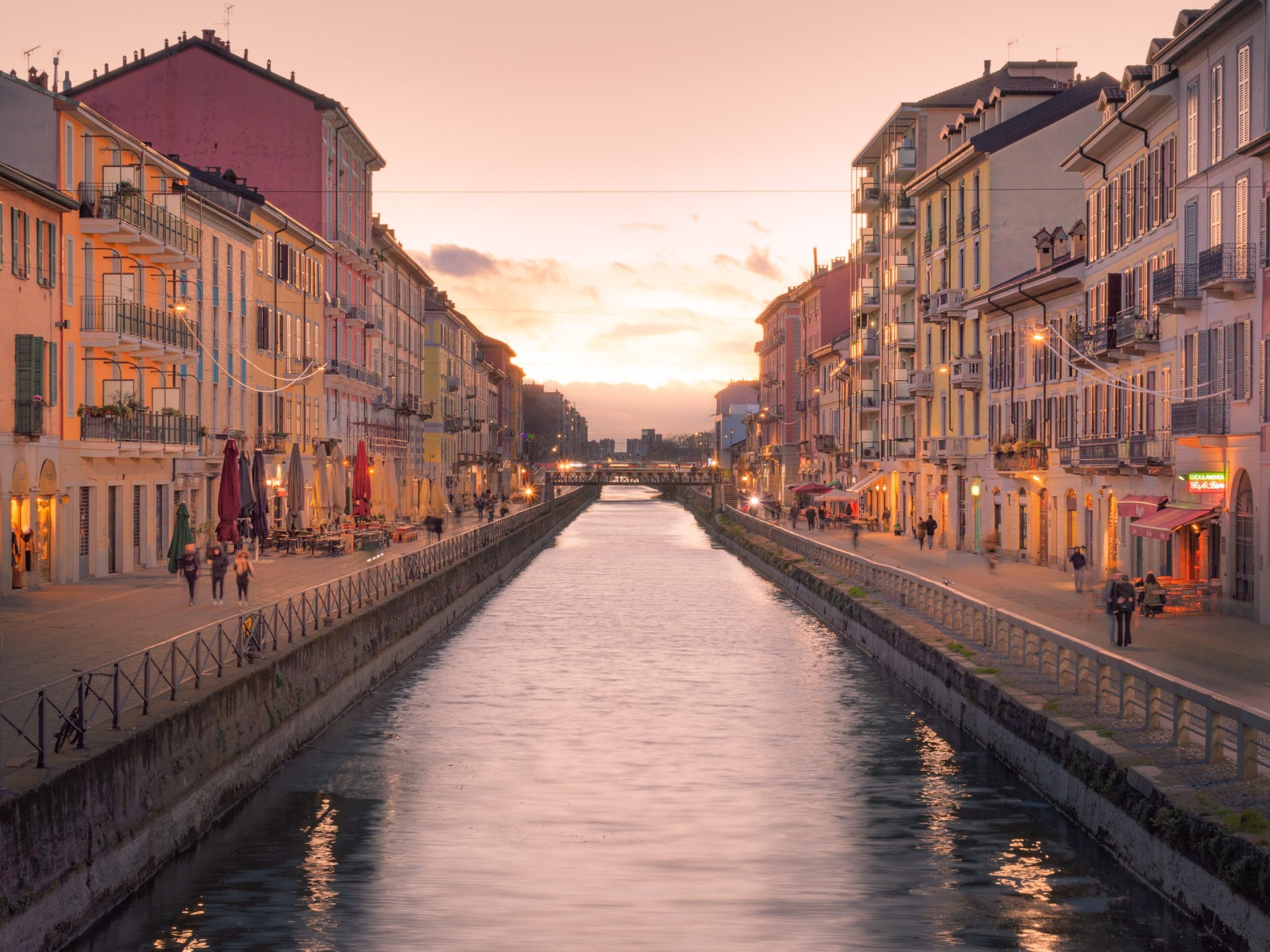
The district is famous for its vibrant nightlife and aperitivo.
Early morning walks along the canals reveal a quieter side of this neighbourhood, when you might encounter fishermen trying their luck, joggers enjoying the peaceful paths, and locals starting their day at corner cafés. The soft morning light reflecting off the water creates an almost painterly atmosphere. At the same time, the absence of crowds allows you to appreciate the architectural details and imagine what life was like when these canals bustled with commercial boats.
Aperitivo Culture
The Navigli district truly comes alive during aperitivo hour—roughly 6:00 to 9:00 PM—when locals gather at canalside bars for pre-dinner drinks and complimentary snacks. This cherished Milanese tradition transforms the waterfront into a buzzing social scene where friends catch up over Aperol spritzes, colleagues decompress after work, and couples enjoy romantic moments by the water. Many travel bloggers cite this as their favourite local experience in all of Italy.
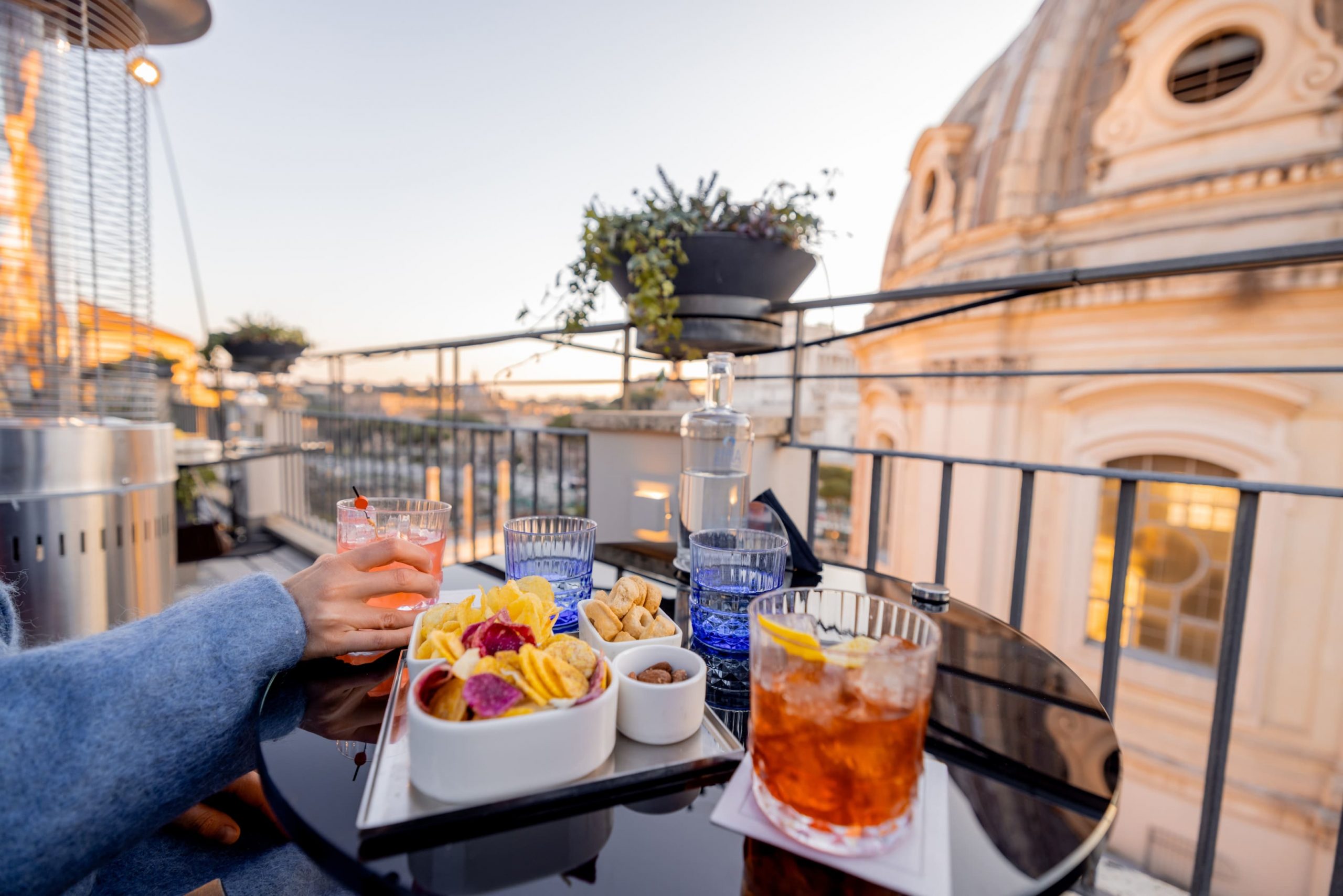
The word aperitivo comes from the Latin word aperire, which means “to open”.
The aperitivo ritual offers wonderful insight into Italian social culture that you won’t fully understand until you experience it. It’s not rushed or merely about the alcohol, it’s fundamentally about connection, conversation, and the pleasure of being together. The complimentary food often becomes surprisingly substantial, with some bars offering elaborate buffets that could substitute for a light dinner.
Beyond the Tourist Path
While visitors have certainly discovered the Navigli district, it retains an authenticity that makes it feel like a genuine neighbourhood rather than a tourist attraction. The local community still lives, works, and socialises here, creating a real neighbourhood energy that’s increasingly rare in historic European districts.
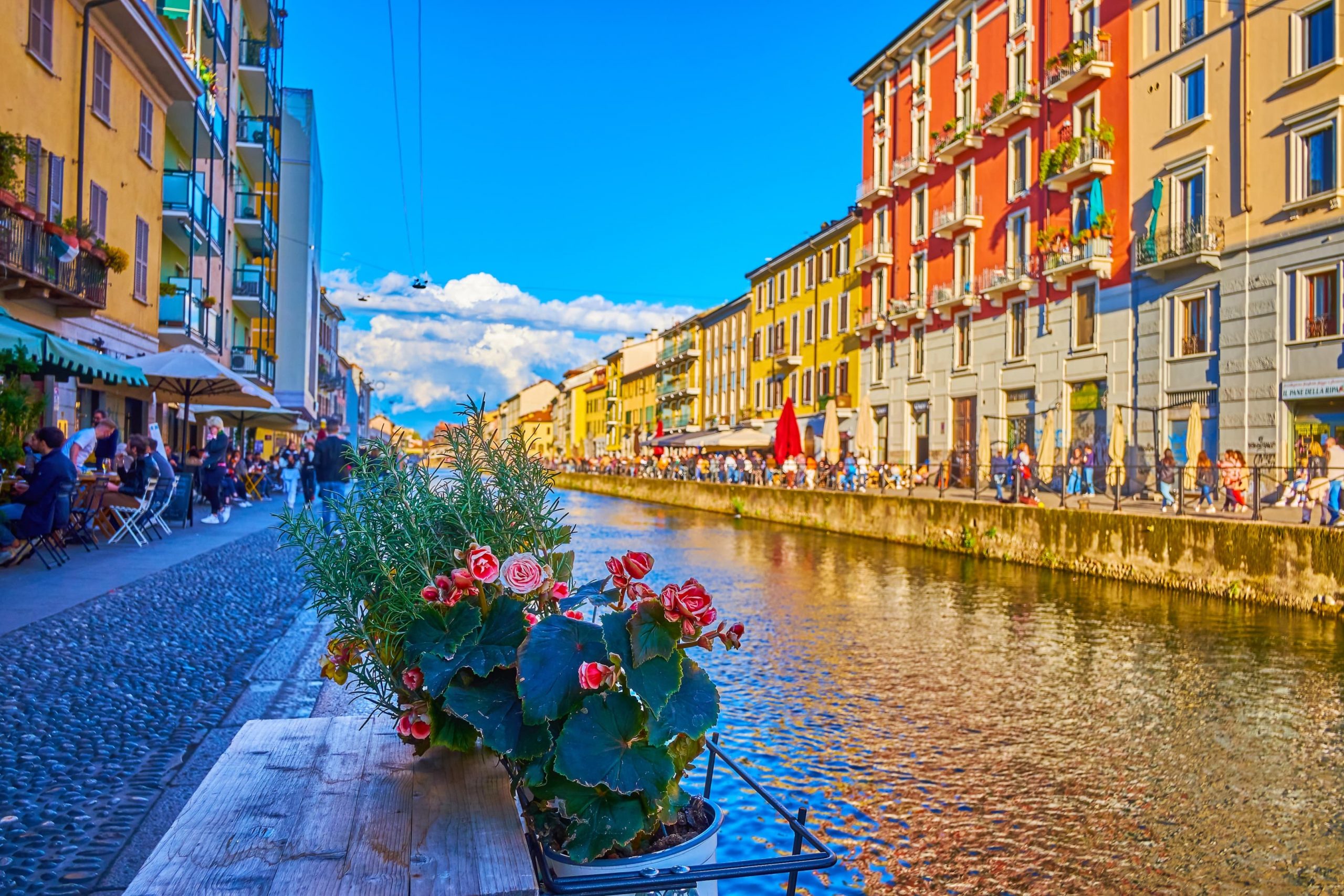
The Navigli District is one of the most beloved, lively, and picturesque neighborhoods in Milan.
On the last Sunday of each month, the Naviglio Grande hosts a popular antique market where vendors spread their wares along the canal banks. You can browse everything from vintage furniture and rare books to old photographs and quirky collectables—a perfect opportunity to discover beautiful places and perhaps find a unique piece of Milan to take home.
Practical Information:
- Metro: Porta Genova (Green Line) provides easy access to the heart of Navigli
- The district is safe and lively until late at night, especially on weekends when locals socialise
- Reserve ahead for dinner at popular waterside restaurants, particularly on Friday and Saturday evenings
- A short walk from the metro station brings you to the heart of the canal district
Savouring Milan: Where to Eat Like a Local
Milan’s culinary scene reflects the city’s sophisticated character—here, traditional Milanese recipes receive the same respect as haute cuisine. Understanding where and what to eat offers crucial insight into local culture and ensures your trip includes unforgettable dining experiences.
Traditional Milanese Cuisine
Authentic Milanese dishes tend to be hearty and rich, reflecting the city’s northern Italian location and historical prosperity. Must-try specialities include:
Risotto alla Milanese: Creamy saffron risotto with a distinctive golden colour and subtle flavour. This seemingly simple dish requires precise technique to achieve the proper creamy consistency—an idea that local chefs take very seriously.
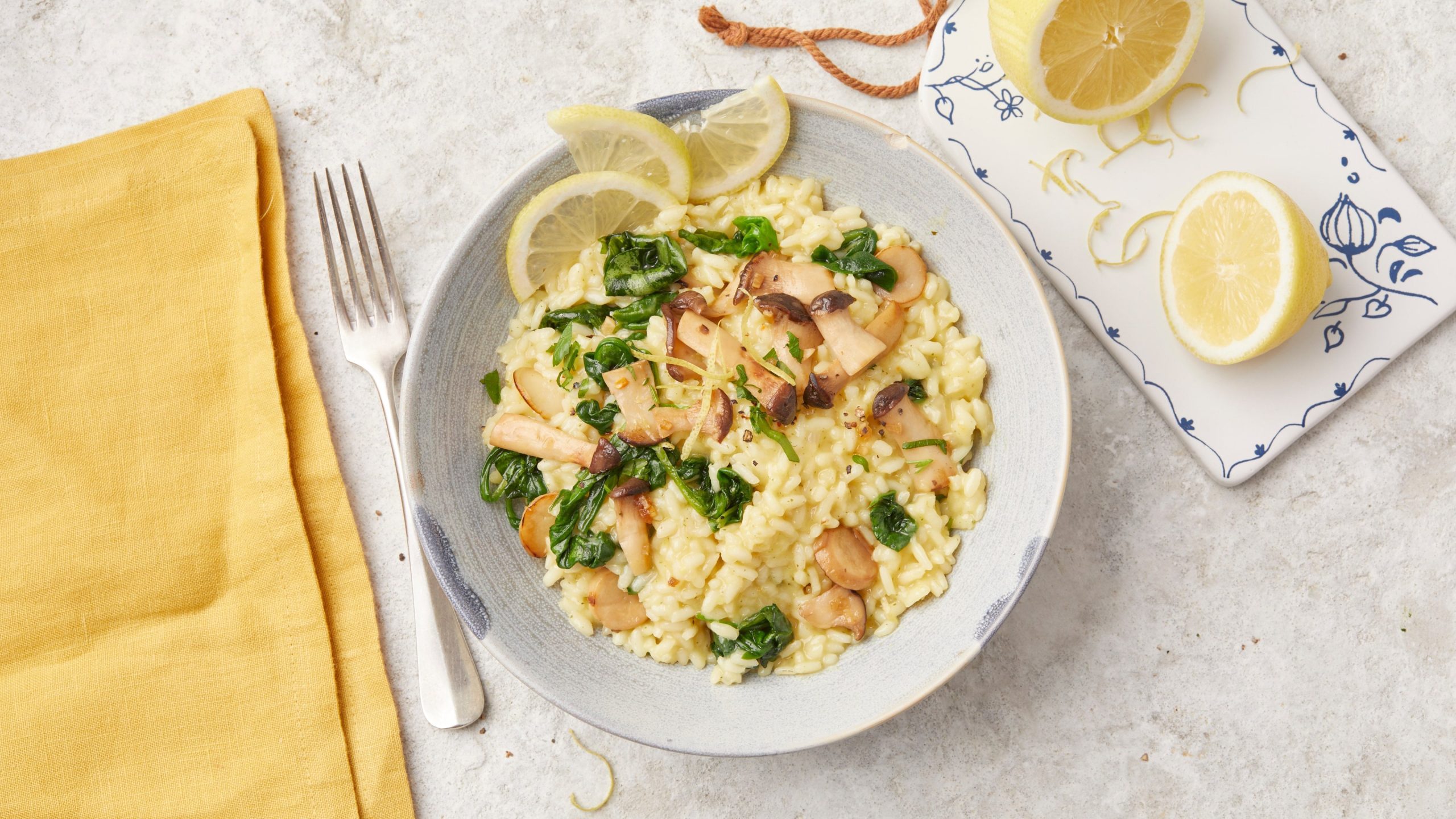
The authentic, traditional recipe is typically known for including veal bone marrow.
Ossobuco: Braised veal shanks cooked slowly until melt-in-your-mouth tender, traditionally served with risotto or polenta. This classic dish represents Milan’s culinary history at its finest.

It is traditionally served with risotto alla milanese (saffron risotto) or polenta.
Cotoletta alla Milanese: A breaded veal cutlet, fried in butter until golden. This dish is so iconic that you’ll find it on menus throughout the city, from simple trattorias to upscale restaurants.
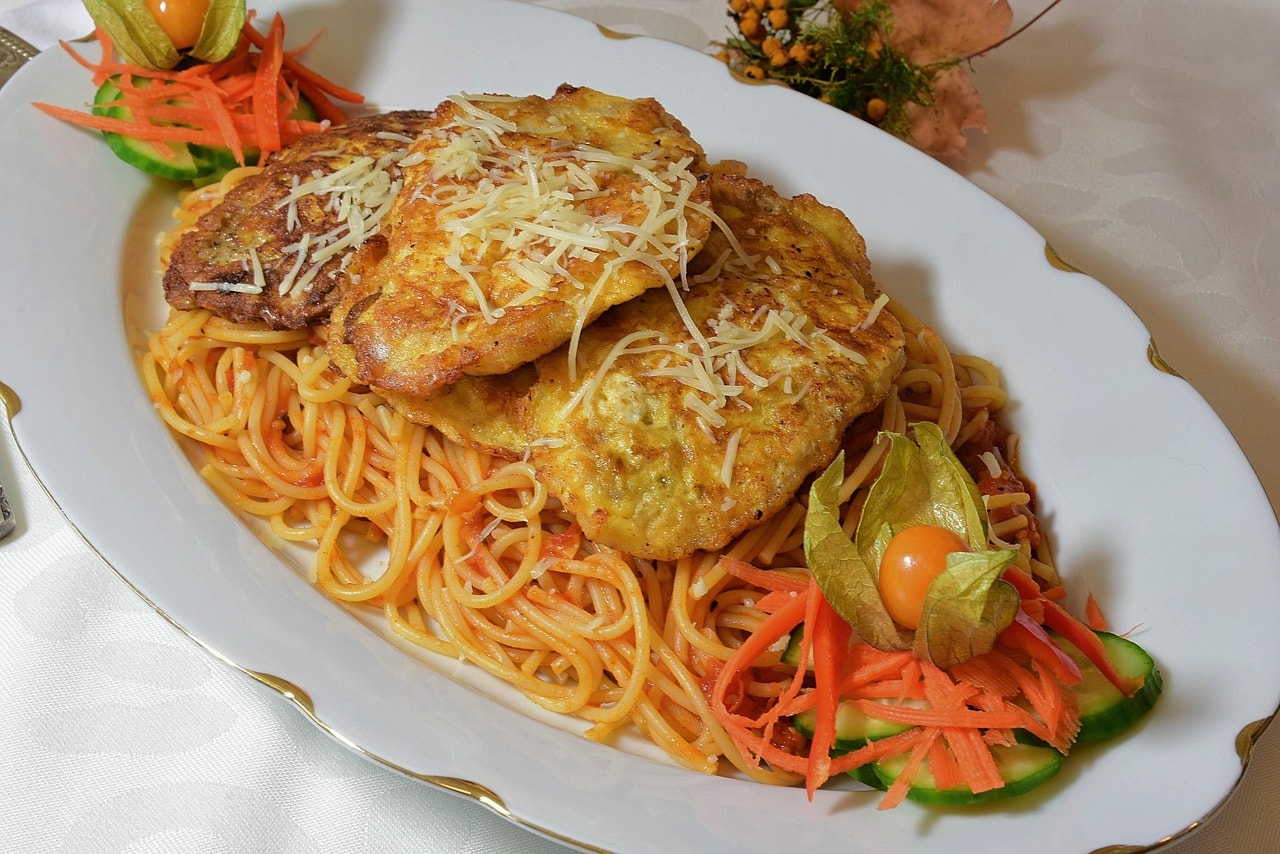
It is traditionally fried in clarified butter (or regular butter) until golden brown.
Panettone: Though associated with Christmas, this sweet bread dotted with candied fruits originated in Milan and remains available year-round at quality bakeries. Taking one home makes a wonderful souvenir from your trip to Italy.

It originated in Milan, Italy, in the Lombardy region.
Where to Dine
Traditional Trattorias: For authentic Milanese cuisine in a warm atmosphere, seek out neighbourhood trattorias. Look for establishments with handwritten menus, simple décor, and mostly local clientele—these usually offer the most genuine local experience and excellent value. The areas around Brera and the Navigli district contain numerous excellent options for lunch or dinner.
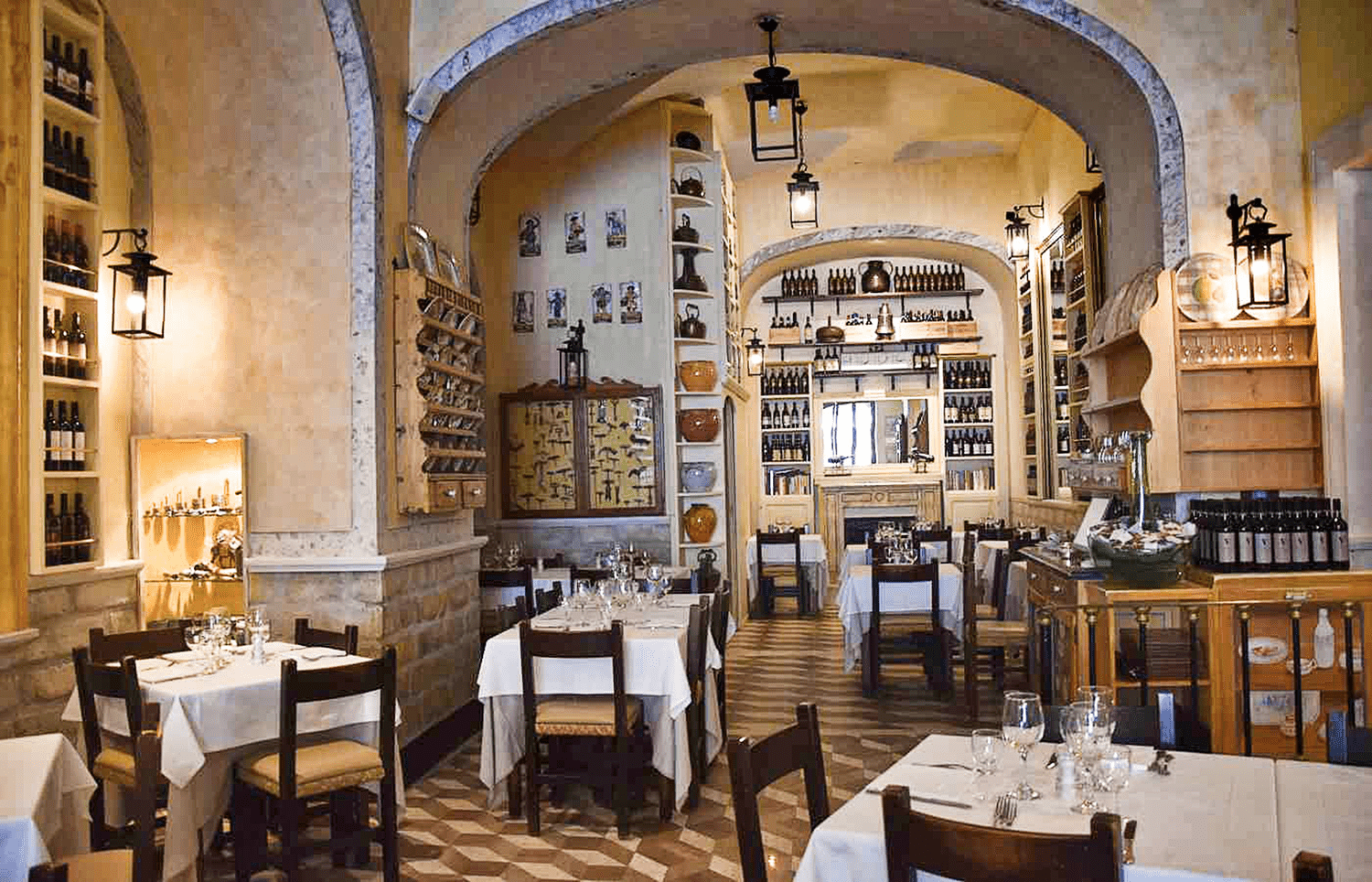
Traditional trattorias are known for embodying Italian culinary tradition and hospitality.
Trattoria Milanese: Located near Santa Maria delle Grazie (a short walk from the Last Supper), this historic restaurant has been serving classic Milanese dishes since 1933. The traditional ambience and expertly prepared regional specialities make it worth booking ahead. This is the kind of authentic restaurant that travel bloggers and locals alike recommend without hesitation.
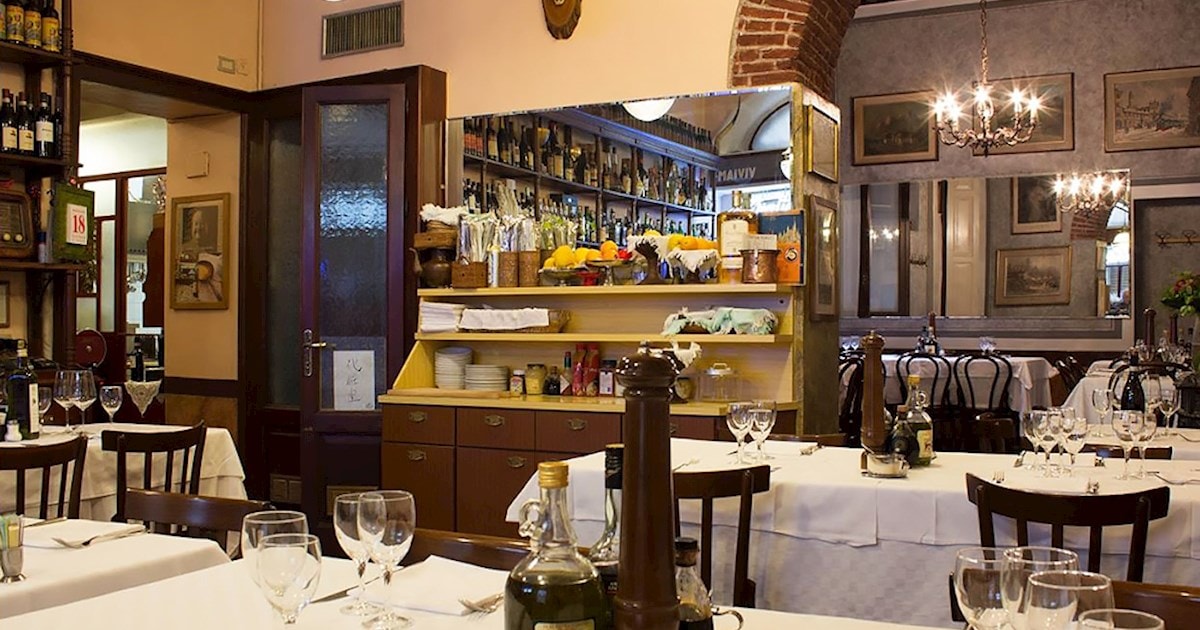
A creamy risotto rich with saffron, which gives it its signature golden hue
Aperitivo Spots: Beyond the Navigli canals, the Brera district, Corso Como, and Porta Nuova areas offer numerous stylish bars where aperitivo culture thrives. Don’t hesitate to explore different neighbourhoods during late afternoon—each has its own aperitivo personality and offers amazing experiences.

This artistic and bohemian district is known for its refinement and stylish, chic venues.
Planning Your Milan Itinerary: Sample Schedules
Whether you have one full day or a long weekend in Milan, thoughtful planning ensures you experience the city’s essential highlights while leaving room for spontaneous discoveries and that precious local experience.
One Full Day in Milan
With just one day in Milan, focus on the must-visit attractions while capturing the city’s essential character:
Morning (8:00 AM – 12:00 PM)
- Arrive at the Milan Duomo when it opens to explore the cathedral with fewer crowds (this early morning timing is crucial)
- Climb to the rooftop for panoramic views in optimal morning light
- Stroll through Galleria Vittorio Emanuele II for shopping or simply admiring the architecture
- Coffee break at a historic café in the city centre
Afternoon (12:00 PM – 6:00 PM)
- Lunch in the Brera district at one of the charming restaurants
- View The Last Supper at Santa Maria delle Grazie (pre-booked supper tickets required)
- Visit either Pinacoteca di Brera or Castello Sforzesco—don’t try to do both if you have a short time
- Walk through Parco Sempione to Arco della Pace for photos
Evening (6:00 PM – 10:00 PM)
- Head to the Navigli district for an aperitivo by the picturesque canals
- Dinner at a traditional trattoria like Trattoria Milanese
- Evening walk along Naviglio Grande to soak in the night atmosphere
This packed itinerary covers the main attractions while still allowing time to breathe and experience local life. We hope you’ll savour each moment rather than rushing between sites.
Long Weekend in Milan (3 Days)
Three days allow deeper exploration while maintaining a relaxed pace—an idea that lets you truly visit Milan without feeling rushed:
Day One: Historic Centre
- Morning: Duomo di Milano interior and rooftop experience
- Late morning: Galleria Vittorio Emanuele II and city centre exploration
- Lunch: Piazza del Duomo area with views of the cathedral
- Afternoon: La Scala Opera House museum and theatre tour (Teatro alla Scala)
- Late afternoon: Window shopping in the Fashion District or a walking tour
- Evening: Aperitivo in Brera, dinner at one of the neighbourhood restaurants
Day Two: Art and Culture
- Morning: The Last Supper viewing at Santa Maria delle Grazie (ensure you have Last Supper tickets booked well in advance)
- Mid-morning: Explore the beautiful church and its cloisters
- Lunch: Near Sforzesco Castle at a local restaurant
- Afternoon: Castello Sforzesco museums and Parco Sempione walk to Arco della Pace
- Late afternoon: Pinacoteca di Brera to see the famous paintings and Leonardo Da Vinci’s works
- Evening: Explore the Brera neighbourhood’s hidden gems, dinner at a local trattoria
Day Three: Modern Milan and Local Life
- Morning: Contemporary art museum exploring modern art (Museo del Novecento or Fondazione Prada)
- Lunch: Trendy restaurant in Porta Nuova showcasing Milan’s modern architecture district
- Afternoon: Shopping, neighbourhood exploration off the beaten path, or hotel rest time
- Late afternoon: Relax before the evening’s activities
- Evening: Navigli canals for aperitivo and dinner experience, possibly antique market if it’s the last Sunday
- Night: Enjoy the vibrant atmosphere along Naviglio Grande
Day Four (Optional Extension)
- Day trip to Lake Como, Bergamo, or Verona by train from the central train station
Day Trips from Milan: Exploring Beyond the City
Milan’s excellent train connections from Milano Centrale (the central train station) make it an ideal base for discovering nearby destinations in Italy, each offering a distinct character that complements your city exploration. These day trip options add variety to your wonderful trip.
Lake Como (1 Hour by Train)
Perhaps the most famous of the Italian Lakes, Lake Como captivates with its dramatic mountain backdrop, elegant villas, and charming waterfront towns. The scenic train journey from the central train station takes approximately one hour—an easy day trip that offers completely different scenery from the city.
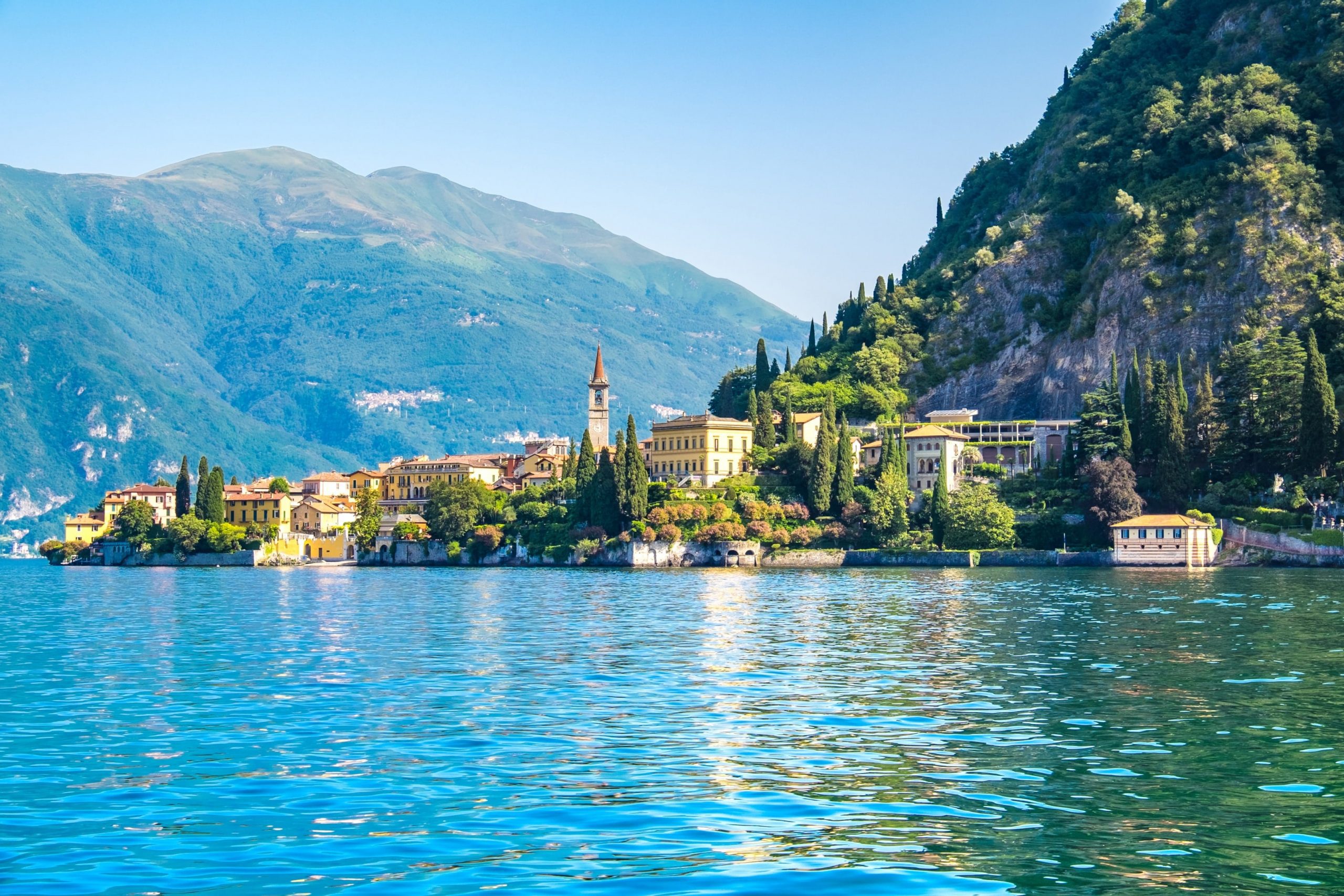
It is one of the deepest lakes in Europe.
What to Experience:
- Explore Como town’s historic centre and lakefront promenade with its beautiful places
- Take a ferry to Bellagio, known for its colourful buildings and gorgeous gardens—travel bloggers consistently rate this as one of the most amazing experiences in northern Italy
- Relax and absorb the serene beauty that has attracted visitors for centuries
Bergamo (50 Minutes by Train)
This beautifully preserved medieval city divides into two distinct sections: the historic Città Alta (Upper Town) perched on a hilltop, and the modern Città Bassa (Lower Town) below. Bergamo offers a wonderful contrast to Milan’s metropolitan energy, representing one of the best-kept hidden gems near the city.
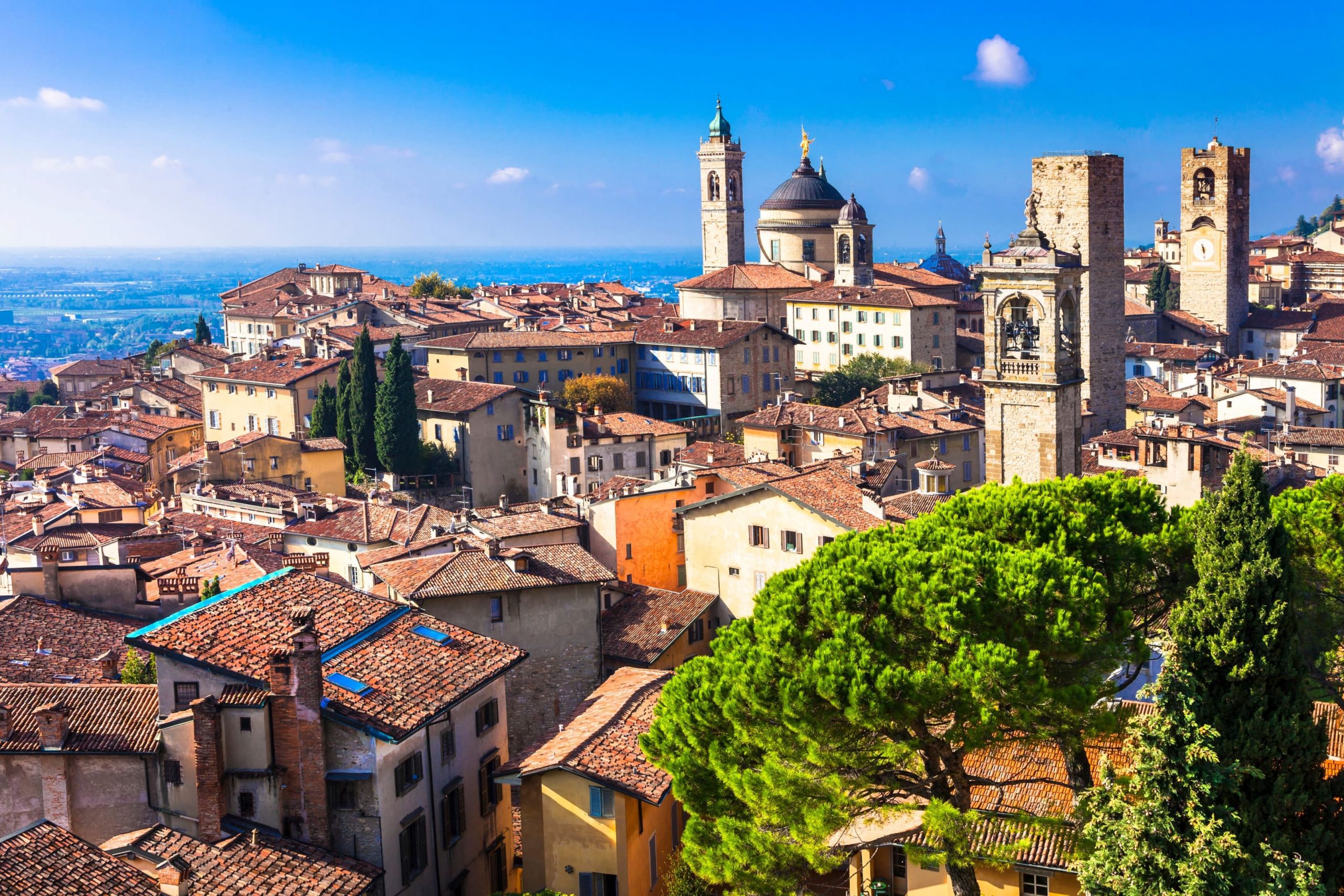
Bergamo is a charming Italian city in the Lombardy region, often visited as a day trip from Milan.
What to Experience:
- Ride the funicular to Città Alta for a cool ascent with great views
- Wander through the medieval Piazza Vecchia, one of Italy’s most beautiful places
- Explore the Romanesque Basilica di Santa Maria Maggiore and the adjacent Colleoni Chapel
Verona (1 Hour 15 Minutes by Train)
Romeo and Juliet’s city combines romance with impressive Roman ruins and well-preserved medieval architecture. Verona makes an excellent day trip for literature lovers and history enthusiasts exploring northern Italy.
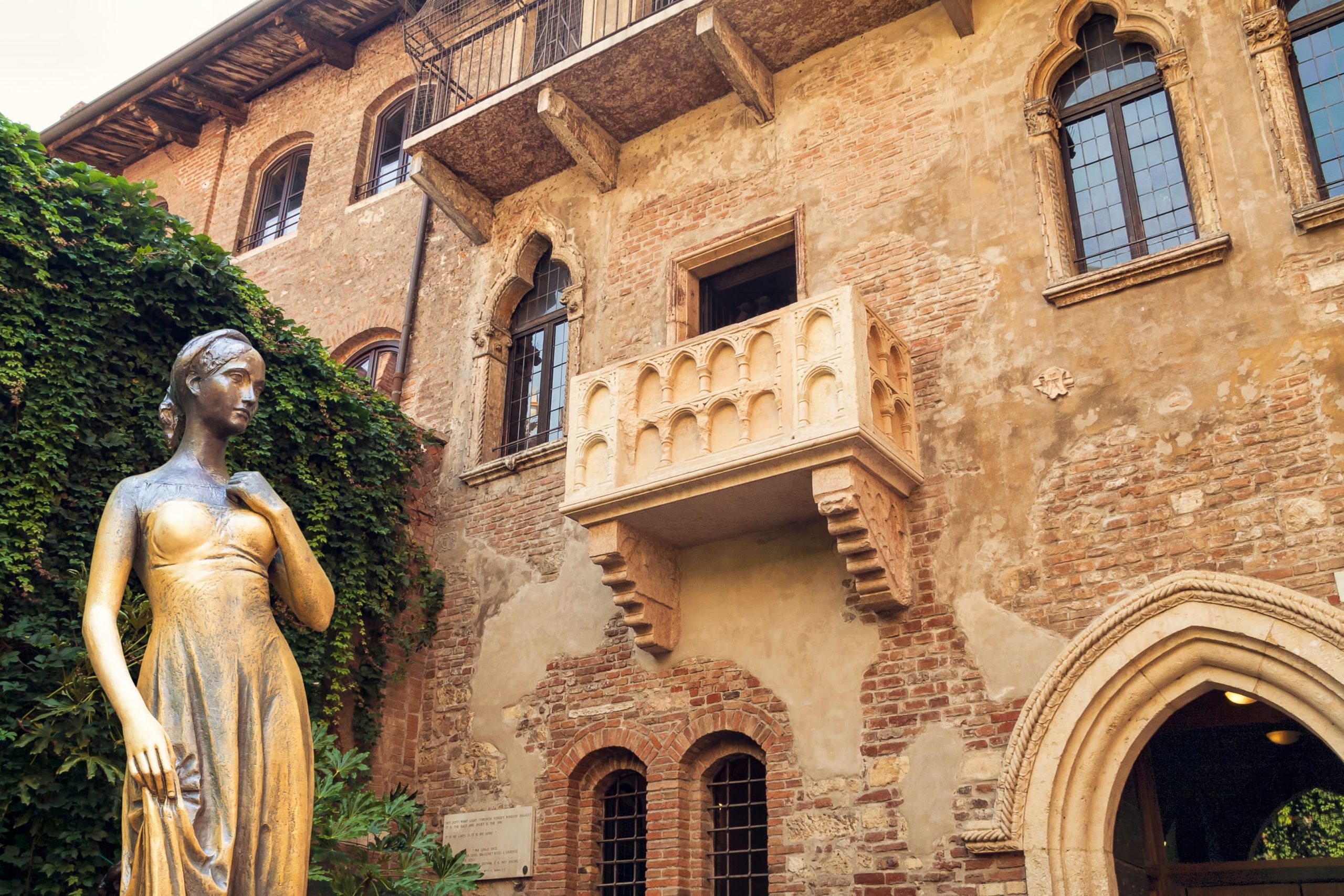
The entire city is a UNESCO World Heritage Site.
What to Experience:
- Visit the Roman Arena, one of the best-preserved ancient amphitheatres in Italy
- See Juliet’s House and balcony (though be prepared for crowds at this main attraction)
- Explore Piazza delle Erbe’s vibrant market square and its history
F.A.Qs
What should you not miss in Milan?
Don’t miss the spectacular Duomo di Milano with its rooftop views, the iconic The Last Supper by Leonardo da Vinci, the elegant shopping arcade Galleria Vittorio Emanuele II, and an aperitivo outing in the lively Navigli canal district.
Is 2 days in Milan enough?
Yes — two days give you time to hit the major sights and soak in the vibe. However, it won’t allow you to explore everything deeply or its surroundings.
What is Milan best known for?
Milan is best known as a global fashion and design capital, a central financial and business hub, and for its rich cultural landmarks and art.
Is Milan worth visiting?
Absolutely — Milan offers world‑class architecture, art, shopping, and transport convenience. Some note it’s more modern/business‑oriented than romantic or historic in style.
Ready to Begin Your Milan Adventure?
Milan awaits with open arms and countless stories to share. From Renaissance masterpieces at Santa Maria delle Grazie to modern art exhibitions, from the elegant Galleria Vittorio Emanuele II to canal-side aperitivo hours, from the soaring heights of the Milan Cathedral to the picturesque canals of the Navigli district, this remarkable city invites you to explore, discover, and create your own Italian memories. Safe travels, and may your time in this amazing city inspire you as it has inspired countless travellers before you.
Visit Italy in another place? Check out our guide for your best travel inspiration.



